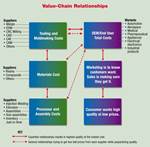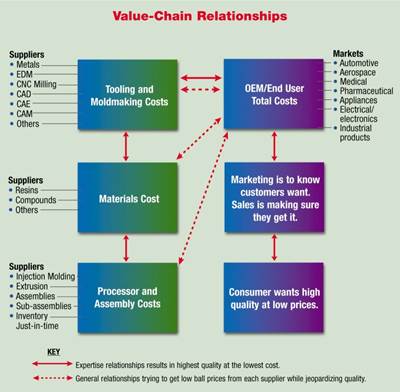Exploring ISO 9000 - Part 19 Servicing
A Series of International Standards for Quality Management and Quality Assurance. The following information was reported in the RAB News and Notes, Winter 2000, Volume 5, Number 1.
Note About ISO9001-2000
The following information was reported in the RAB News and Notes, Winter 2000, Volume 5, Number 1:
"Replacement of the 1994 edition of ISO9001, ISO9002 and ISO9003 with a single requirements standard, ISO9001:2000 will require the use of a very clear and concise description of the activities of an organization that are included in the registration process.
Attention should be given to the requirement in the DIS (Draft International Standard), which states that the organization may only exclude QMS requirements that neither affect the organization's ability nor absolve it from its responsibility to provide product that meets customer requirements and applicable regulatory requirements (Section 1.2 Permissible exclusions).
It is now clear, for example, that an organization that designs its own products may not exclude design control from its quality management system."
For those of you that have registered to ISO9002 and indeed do design work, you must incorporate ISO9001:2000 Section 7.3 Design and/or Development in your quality system update.
Element 4.19 Servicing
"Where servicing is a specified requirement, the supplier shall establish and maintain documented procedures for performing, verifying and reporting that the servicing meets the specified requirements."
General Observation
As of this writing, I have not encountered a client in the plastic injection or mold/tool business providing after-sales service as part of a contract. There are times when companies agree to warranties. However, the customer must return the mold to the manufacturer for rebuild services. With product manufacturers, the only services-like actions result from customer complaints about nonconforming product. This activity is not considered servicing.
One customer satisfaction opportunity may be to offer after-sale services including technical assistance, setup, operations and maintenance of product, i.e., mold/tool. Consider value-added services that your customer may be willing to pay a premium for - especially with current labor shortages.
"Where servicing is a specified requirement ..."
Action Items
During contract review identify any specific service contractual requirements. If the customer requires after-sales service, your contract should clearly describe the nature, terms of coverage and duration of services. Develop a procedure to document your service process.
A. Performing Services
Think about the Maytag repair technician. This technician is trained to service and repair Maytag units wherever they are located. Training (4.18) becomes a key documented requirement. The technician will refer to service, repair and maintenance manuals (4.9 and 4.5) for guidance. The technician will transport and use tools and equipment to complete the service work (4.11).
B. Verifying Service
Upon completion of services, how do you verify such services meet the customer-specified requirements? Common sense follows with a trial run operation following procedural measurements to determine adequate operation. The Maytag technician operates the unit to ensure that the rinse cycle works to specifications.
C. Reporting Services
Reporting refers to service records or reports that should include the appropriate information about each service situation. Document: customer name, location, product identity, in-service date, date of service performed, name of technician performing service, condition of the unit before service, details of services performed - including all parts and adjustments, details of verification, signature of customer and total service time.
If you do comply with Element 4.19 use the reported service data for trend analysis linked to 4.9, 4.14 and 4.15 and consider reporting the results during Management Review meetings.
Examples of after-sale services include your heating/cooling company. For those of you living in the Northeast and heating with oil, you know to what I am referring. Most likely, you have purchased a yearly service contract to cover specific service and parts requiring repair. When your heating system fails both parts and labor will be covered under the contract.
A second example is HP selling computers and offering on-site service for one year. If the hardware fails for mechanical reasons, HP will send a technician to repair or replace the unit.
If either your heating contractor or HP were ISO 9001-certified, they would have to meet Element 4.19 requirements.
Q9000-2-1997 Guidance
"When the functionality of products may depend on servicing for maintenance or proper use of the products and when the supplier provides for some of or all of the product servicing by warranty or by con-tract, the supplier's quality system should include provisions for the type and extent of servicing provided. The following activities should be considered as appropriate:
- Clarification of servicing responsibilities among supplier, distributors and users.
- Planning of Service activities, either carried out by the supplier or a separate agent.
- Validation of design and function of special-purpose tools or equipment for handling and servicing products after installation.
- Control of measuring and test equipment used in (after sales) servicing and tests.
- Provision and suitability of documentation, including instructions for use in dealing with the spares or parts lists and in servicing the product.
- Provision for adequate backup to include technical advice and support, customer training and spares or parts supply.
- Training of service personnel.
- Provision of competent service personnel.
- Feedback of information that would be useful for improving product or service design.
- Other customer support activities.
Related Content
Dynamic Tool Corporation – Creating the Team to Move Moldmaking Into the Future
For 40+ years, Dynamic Tool Corp. has offered precision tooling, emphasizing education, mentoring and innovation. The company is committed to excellence, integrity, safety and customer service, as well as inspiring growth and quality in manufacturing.
Read MoreWhat is Scientific Maintenance? Part 2
Part two of this three-part series explains specific data that toolrooms must collect, analyze and use to truly advance to a scientific maintenance culture where you can measure real data and drive decisions.
Read MoreMMT Chats: The Connection Between Additive Manufacturing Education and ROI
This MMT Chat continues the conversation with Action Mold and Machining, as two members of the Additive Manufacturing team dig a little deeper into AM education, AM’s return on investment and the facility and equipment requirements to implement AM properly.
Read MoreThe Role of Social Media in Manufacturing
Charles Daniels CFO of Wepco Plastics shares insights on the role of social media in manufacturing, how to improve the “business” side of a small mold shop and continually developing culture.
Read MoreRead Next
Are You Ready for ISO Certification?
ISO certification just may give you the competitive edge that you need to survive in this economy.
Read MoreHow to Use Strategic Planning Tools, Data to Manage the Human Side of Business
Q&A with Marion Wells, MMT EAB member and founder of Human Asset Management.
Read MoreHow to Use Continuing Education to Remain Competitive in Moldmaking
Continued training helps moldmakers make tooling decisions and properly use the latest cutting tool to efficiently machine high-quality molds.
Read More





















